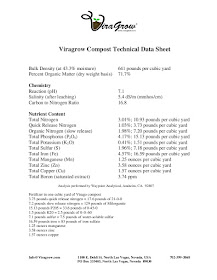 |
| Some composts, if they are rich enough in nutrients, can be used like a fertilizer. |
A. Yes you can. But please
be aware that homemade compost is not consistent in fertilizer content and
quality. This is because of variability of different nutrients in ingredients
used to make the compost. However, compost is universally good, whether it’s
commercial or homemade, when added to soils as a soil amendment.
When using compost as a substitute for fertilizer, it is
important to know its carbon to nitrogen ratio, in other words how much
nitrogen fertilizer it contains. The nitrogen content of a compost is critical.
High nitrogen content (low carbon to nitrogen ratio) makes compost “hot” and
less of it should be used. If compost has a high carbon to nitrogen ratio (low
nitrogen content), then more of it should be applied when substituting it for
fertilizer
Commercial composts aim for a carbon to nitrogen ratio close
to 20:1 or twenty times more carbon than nitrogen. As this ratio increases to
40:1, the nitrogen fertilizer content decreases. At a ratio more than 40:1, the
compost is still valuable but it’s value is greater as a soil amendment rather
than fertilizer.
The carbon to nitrogen ratio in homemade compost is
managed through what is added to the compost mix before composting. “Woody”
additions to compost like wood chips, sawdust and shredded newspaper (sometimes
referred to as the “brown” component) increase the carbon to nitrogen ratio.
Additions of grass clippings, leaves of trees and shrubs,
and vegetable scraps (referred to as the “green” component) lowers the carbon
to nitrogen ratio and make it more valuable as a fertilizer.
Animal manure (think of it as a concentrated “green”
component) is high in nitrogen and added to get the carbon to nitrogen ratio
low and improve fertilizer content. If lots of different components are mixed
together in the right proportions, green components are balanced with brown
components, homemade compost has all the nutrients needed by plants.
The short answer is “yes”.
But substituting a homemade compost for a fertilizer application varies from
batch to batch depending on what was used to make the compost.


No comments:
Post a Comment